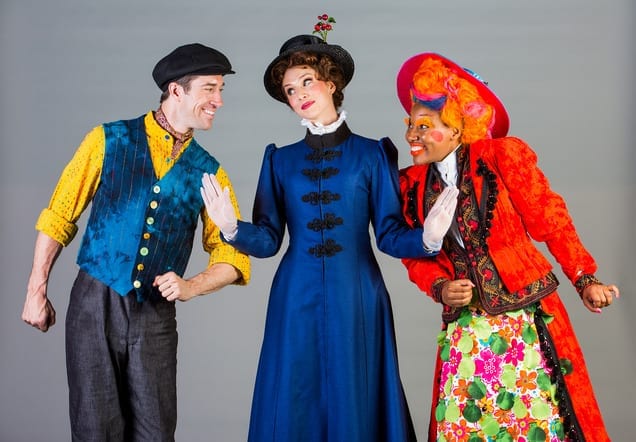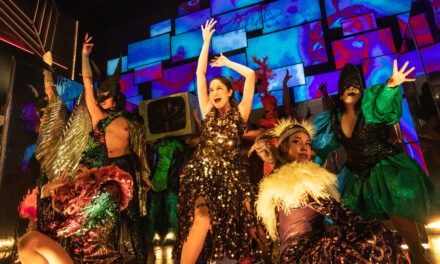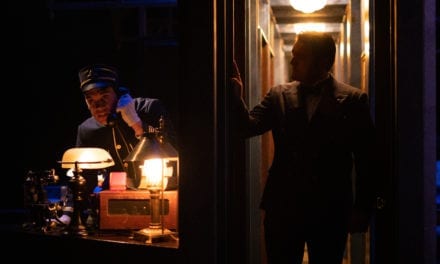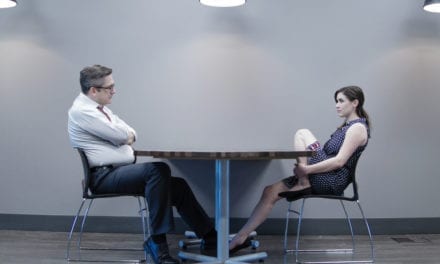IVINS — Thousands of miles away from where the show ran on Broadway and in London, the Tuacahn amphitheatre presents Mary Poppins as perhaps only a red rock amphitheatre can. Disney and Cameron Mackintosh‘s Mary Poppins is based on the book series by P.L. Travers and the 1964 Disney movie, following the Banks family as each member undergoes the transformations necessary to live happily together under one roof. Of course, none of these transformations would be possible without the aide of their practically perfect nanny, Mary Poppins (Mindy Smoot Robbins). Accompanied frequently by her counterpart Bert (Jesse Swimm), Mary guides the children through a string of adventures that teaches them about kindness, gratitude, hard work, and fun. Meanwhile, the children’s parents, George (David Engel) and Winifred (Jennifer Evans) Banks, are studying life’s lessons about self-confidence and priorities. Having gained perspective, the family reunites, realizing that together, “Anything Can Happen.”
Combining that “anything can happen” theme with the seemingly limitless resources of Tuacahn, director Scott S. Anderson brought a lot of excitement to the stage. Mary Poppins pulled an entire hat stand from a carpet bag, there for all to see. Bert danced on the ceiling. The show ended with fireworks. And watching a spotlit Mary Poppins float past the red rock, descend through the blue sky, and land via umbrella straight onto the stage embodied the technical magic of Tuacahn. But despite these huge moments, this musical sometimes felt small.
The stage itself is huge. Sets designed by Doug Ellis helped direct audience focus to the center of the stage where most of the scenes were played. The main set, a large flat with three rotating panels, featured three dimensional aspects including a staircase and doors representing the interior of the Banks home. The opposite side of each rotating panel was painted with a light wash of the building’s exterior. Additional locations were created by projecting backgrounds on this lightly painted exterior. While the trees in one projection looked like a photograph, another scene looked more like a drawing. None looked like the same style that had been used to paint the physical set pieces. Though effective in identifying the scenes location, these projections disrupted the continuity of the production.
There were other elements of the production that lacked continuity as well. Many of the effects used added to the story and were executed professionally. During “Practically Perfect,” Mary Poppins stopped in front of a mirror and adjusted her hair. When she bent down to reach within a drawer, her reflection stayed active in the mirror. This impressive effect helped develop Mary’s mystical character. A kitchen rigged to fall to shambles allowed the children to create a big mess and set the stage for Mary’s magical repairs in “A Spoonful of Sugar.” But later, a vase designed to fall and break into several pieces landed with no sound at all – either an oversight or a missed sound cue that distracted from the scene.
Occasionally, a visual reference was made to the 1964 movie, but without any context to support the story. One example of this was the appearance of dancing penguin in “Jolly Holiday.” Had their been a whole waddle of penguins or specific penguin-like choreography, this could have supported the whimsy of the song. Having enjoyed Jesse Swimm’s dancing in all other areas of the show, I think I would have very much enjoyed watching him join the penguin for a few measures. But this did not happen, so there was just a penguin on stage amid the dancing statues, without any clear purpose.
Perhaps the most disappointing aspect was the choreography. Rommy Sandhu showed exactly what could be done in huge moments like the spelling section of “Supercalifragilisticexpialodocious” and “Step in Time,” which each turned into the huge production numbers I had expected. But with such a large stage and talented cast of dancers, I was generally underwhelmed by the scope of the numbers. It also seemed that the actors and dancers frequently stepped out of the scene to do their dancing. This was particularly true when rolling scenery was used, such as in “A Spoonful of Sugar,” which took place mostly in front of the kitchen. Because much of the staging and choreography remained in a small percentage of the stage, I couldn’t help but wonder how big the show could have been if it had used all of the available space.
Even somewhat inconsistent was the show itself. With original music and lyrics by Richard M. Sherman and Robert B. Sherman and a book by Julian Fellowes, Mary Poppins brought more than just the familiar melodies from the 1964 movie. Unfortunately, the best songs were the ones from the 1964 movie. Additional songs like “Practically Perfect” expanded on an premise that may not have been big enough for an entire song. Despite the fun effects used the in song, I just couldn’t stay interested for the duration. In addition, the many adventures often felt like little more than an excuse to go in search of a production number. This was especially true of the first act. The plot finally became interesting, and far more consistent, in the second act as the characters rallied together to solve much more specific conflicts.
Despite its minor flaws, I would consider this production very good. For any small criticism I could argue, there were a myriad of successes throughout the production. Many of these I would simply expect from a professional theater with the resources of Tuacahn. The costumes, designed by Janet L. Swenson, were iconic and vibrant and were fitted perfectly to each character. My favorite pieces were the overcoats worn by Mary Poppins, Winifred Banks, and Jane Banks (Lauren Allen). The orchestra, conducted by Camille Villalpando Rolla, had me checking my program to see whether this was a practically perfect orchestra or the most realistic prerecorded track I had ever heard.
As with most stage productions, it was the talents of the actors and actresses which make the biggest impression. It is difficult to offer specific compliments to this cast who was, in every case, exactly what the music, staging, and iconic childhood memories demanded. An unexpected standout was Mrs. Brill (Heidi Anderson), the Banks’ cook and housekeeper. Anderson’s dry humor and perfect timing provided plenty of opportunities to laugh. I was also particularly impressed by the ability of both children, Grant Westcott as Michael Banks and Lauren Allen as Jane Banks, to use large physical movements to develop their characters. Often blocked with her back to the audience, Allen’s emphatic movements would cause the huge bow in her hair to sway, adding a visual punctuation mark to each sentence she spoke. And because I am uncertain if a first grade boy will consider “cute” to be a compliment, Westcott was the perfect combination of sweet and precocious. It was no wonder that he received thunderous applause during the curtain call. Another surprise was Evans as Winifred Banks. This adaptation portrays Mrs. Banks as woman who is struggling to play the part of dutiful wife. Evans delivered an authentic emotion in her songs making “Being Mrs. Banks,” the best new song in the score.
Under the musical direction of Camille Villalpando Rolla, each of the soloists delivered beautiful renditions of both the new and well-known songs. Nicole Powell’s “Feed the Birds,” was soulful and moving and showed authenticity to the well known movie version. Considering only the music, this musical truly was practically perfect. Even the particularly high notes of “Brimstone and Treacle” (Parts 1 and 2) were delivered flawlessly by both Robbins and by Janna Cardia as Miss Andrew. Several songs required Westcott and Allen to hold harmonies while Robbins sang the melody. In each of these moments, the harmonies were accurate and balanced. In fact, the only moments in which the music was less than perfect were when several adults attempted harmonies. Although each note individual note was accurate, the wide vibratos of several characters created a messy sound sometimes barely identifiable as a chord. First occurring at the end of “Cherry Tree Lane,” this unfortunate phenomenon happened continuously throughout the production.
Though I mentioned that the choreography lacked in some aspects, when it was big, – it was amazing. “Supercalifragilisticexpialodocious” grew as it progressed, and when it hit the adapted spelling section, it was a visual spectacle. Swimm started off the full-body spelling bee then passed the action off to Allen. As the ensemble joined in synchronously displaying each letter, the intensity grew as limbs appeared to be flying. Even young Westcott was involved, keeping up impressively with the speed of the movement. However, it was when the lights changed to cast large shadows of the cast on the back wall that the movement became almost hypnotic. I found myself watching the shadows, impressed as each shadow moved in exact time with its neighbors. When it came time for “Step in Time,” I mentally crossed my fingers, hoping Sandhu would pull out all the stops. In this number, I felt the thrill of a big Broadway production number the way I had been hoping for all night. If this whole production had been “Step in Time,” I would have been on my feet clapping continuously.
Tuacahn’s Mary Poppins provides a great opportunity to experience the excitement of this international hit right here in Utah. Though I can’t quite say I loved every moment, I certainly enjoyed a night full of exceptional talent and unique stage effects. What this production lacked in continuity and scope, it made up for in truly magical moments and consistent talent. If you have fond memories of the 1964 movie, you will very likely enjoy this adaptation. For those living in or vacationing in St. George, plan to add Mary Poppins to your list of summer activities. Your family will enjoy this theatrical spectacle. No spoonful of sugar necessary.







